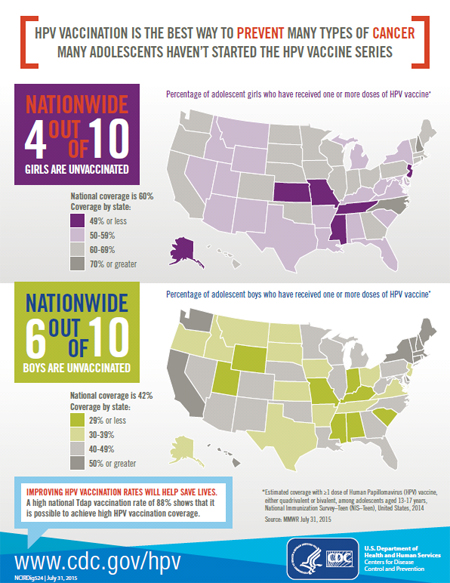Many adolescents still not getting HPV vaccine
Large vaccination increases in some states offer clues to effective interventions
Press Release
Embargoed Until: Thursday, July 30, 2015, 1:00 p.m. ET
Contact: 
HPV vaccination is the best way to prevent many types of cancer many adolescents haven’t started the hpv vaccine series.
Entire Infographic
The number of 13- to 17-year-old boys and girls getting the human papillomavirus (HPV) vaccine increased slightly for the second year in a row, according to data from CDC’s 2014 National Immunization Survey-Teen (NIS-Teen), published in this week’s Morbidity and Mortality Weekly Report (MMWR).
Despite these increases, 4 out of 10 adolescent girls and 6 out of 10 adolescent boys have not started the recommended HPV vaccine series, leaving them vulnerable to cancers caused by HPV infections. Persistent HPV infections can cause cancers of the cervix, vagina, and vulva in women; cancers of the penis in men; and cancers of the anus and oropharynx (back of the throat, base of the tongue, and tonsils) in men and women. CDC recommends the vaccine for girls and boys at age 11 to 12 years.
The latest estimates show that 60 percent of adolescent girls and 42 percent of adolescent boys have received one or more doses of HPV vaccine. This was an increase of 3 percentage points for girls and 8 percentage points for boys from the 2013 NIS-Teen survey estimates.
While there was a 3 percentage point overall increase nationally for first-dose HPV vaccine coverage among adolescent girls, a handful of state and local areas achieved much larger increases in coverage.
“The large increases in these diverse parts of the country show us it is possible to do much better at protecting our nation’s youth from cancers caused by HPV infections,” said Dr. Anne Schuchat, assistant surgeon general and director of CDC’s National Center for Immunization and Respiratory Diseases. “We are missing crucial opportunities to protect the next generation from cancers caused by HPV.”
Some of the promising strategies that have been effective in combination at increasing receipt of HPV vaccine include:
- Establishing links between cancer organizations and immunization organizations to emphasize HPV vaccination is cancer prevention;
- Health care provider education initiatives, including reminding doctors and nurses to take every opportunity to strongly recommend HPV vaccine, especially when they recommend the two other vaccines recommended at age 11 to 12 years (the quadrivalent meningococcal conjugate and Tdap vaccines) and the annual flu vaccine;
- Practice-based quality improvement efforts by state and local health departments, such as assessment of a clinic’s HPV vaccination coverage levels and providing feedback on how to improve coverage;
- Public communication campaigns; and,
- Reminder-recall interventions, such as using immunization information systems to send reminders to parents about vaccinations for which their child is due.
The relatively large increases in HPV vaccination seen in some states mask the lack of progress in other states. Every year, about 27,000 women and men in the United States are diagnosed with a cancer caused by HPV infection. HPV vaccination could prevent the majority of these cancers from ever developing.
“HPV vaccine prevents cancer,” said Dr. Schuchat.
Research shows that an effective recommendation from a healthcare professional is crucial to a parent’s decision to get the HPV vaccine for their child. CDC encourages clinicians to recommend HPV vaccine the same way and same day they recommend other vaccines for adolescents.
Preteens need four vaccines at ages 11 or 12 years to protect against serious diseases: quadrivalent meningococcal vaccine to protect against meningitis; HPV vaccine to protect against HPV infection and HPV cancers; Tdap vaccine to protect against tetanus, diphtheria, and pertussis, or whooping cough; and an annual flu shot to protect against seasonal flu. A second dose of meningococcal vaccine is needed at age 16.
CDC encourages parents and caregivers to talk to their child’s doctor or nurse at their next healthcare encounter. If a preteen or teen has not received all doses of these vaccines, make an appointment to get him or her vaccinated.
The NIS-Teen is a random-digit-dialed survey of parents and guardians of teens 13–17 years old and in 2014, included data for more than 20,000 adolescents. The telephone survey is followed by a mail survey that collects vaccination information from health-care providers.
Today’s article will be available on the Morbidity and Mortality Weekly Report website at http://www.cdc.gov/mmwr/ after the embargo lifts at 1 p.m. ET.
For more information on the National Immunization Survey (NIS), please visit:
http://www.cdc.gov/vaccines/imz-managers/nis/about.html
Preteen and Teen Vaccines:
http://www.cdc.gov/vaccines/teens
HPV Vaccine Resources for Healthcare Professionals:
http://www.cdc.gov/vaccines/YouAreTheKey
HPV Vaccine Information for Parents and Public
http://www.cdc.gov/hpv